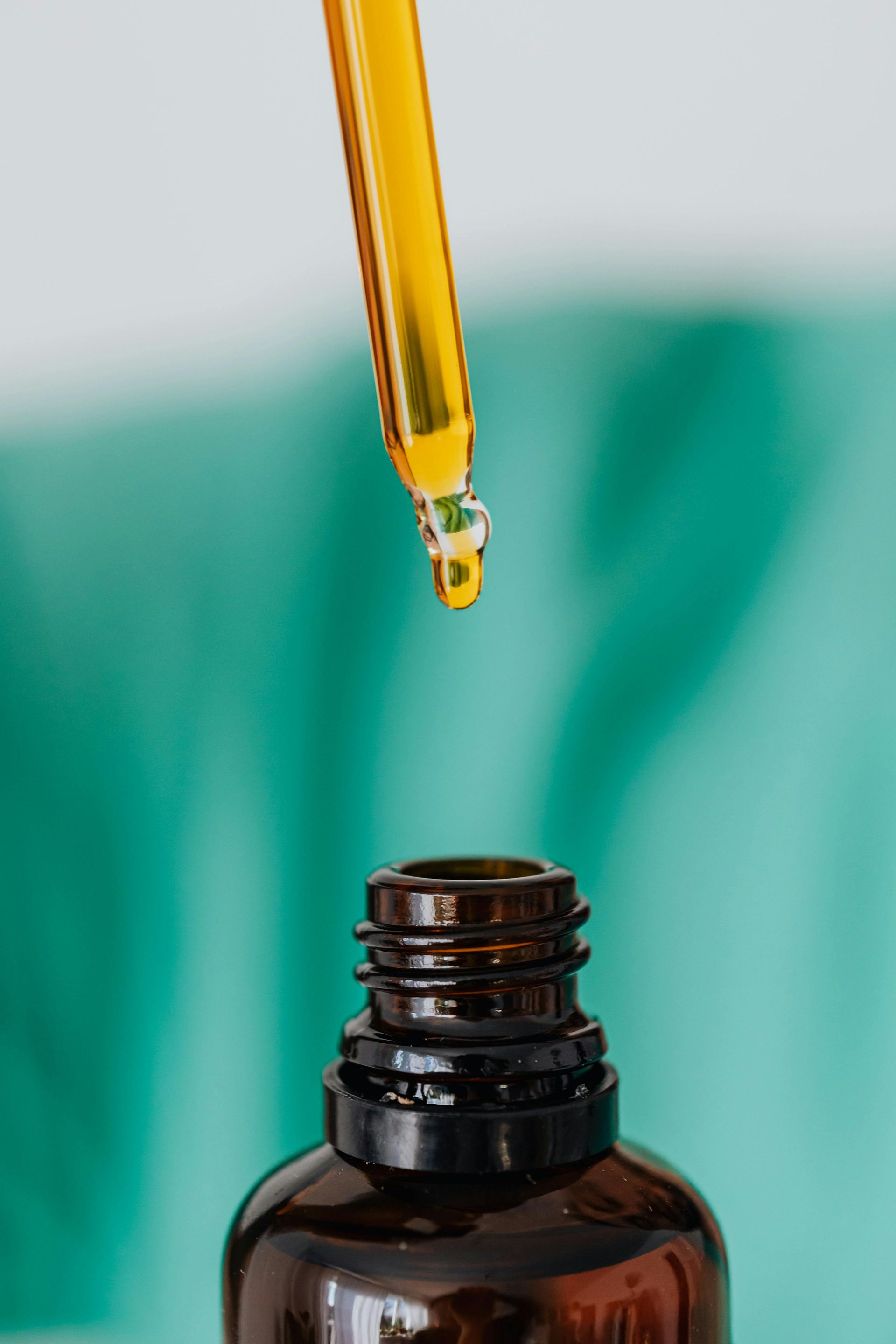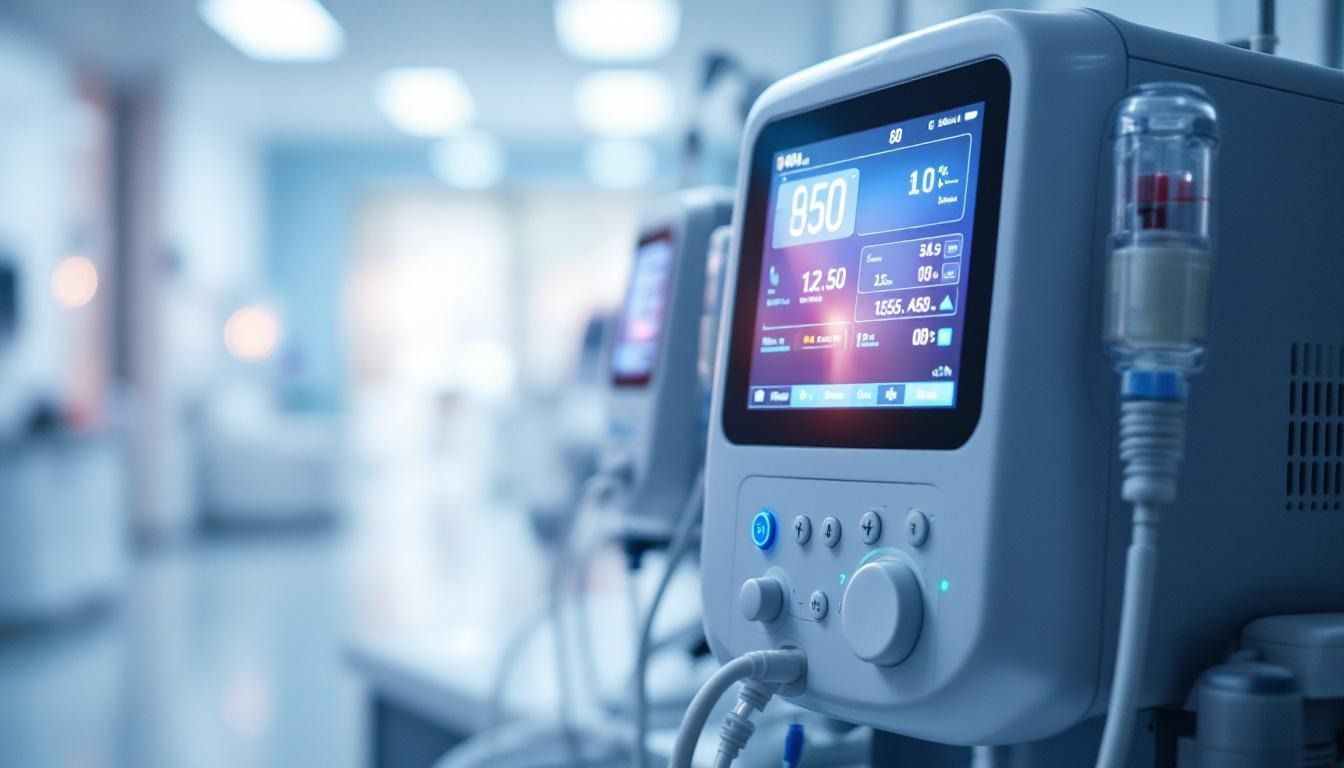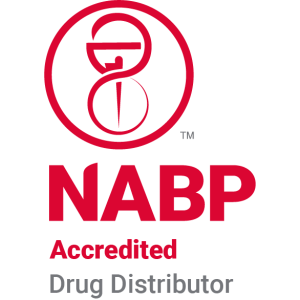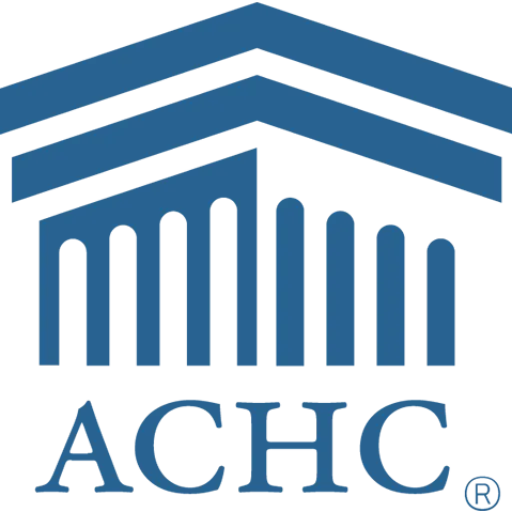Common Conditions That Require TPN for Nutritional Support
Understanding the Role of TPN in Managing Gastrointestinal Conditions
Total Parenteral Nutrition (TPN) is a vital life-saving therapy used when the gastrointestinal tract cannot adequately absorb or tolerate nutrients due to various medical conditions. This article explores the common conditions necessitating TPN, its composition, clinical indications, administration protocols, and the potential complications involved, providing a comprehensive overview of this essential clinical intervention.
Conditions Requiring TPN and Their Clinical Contexts
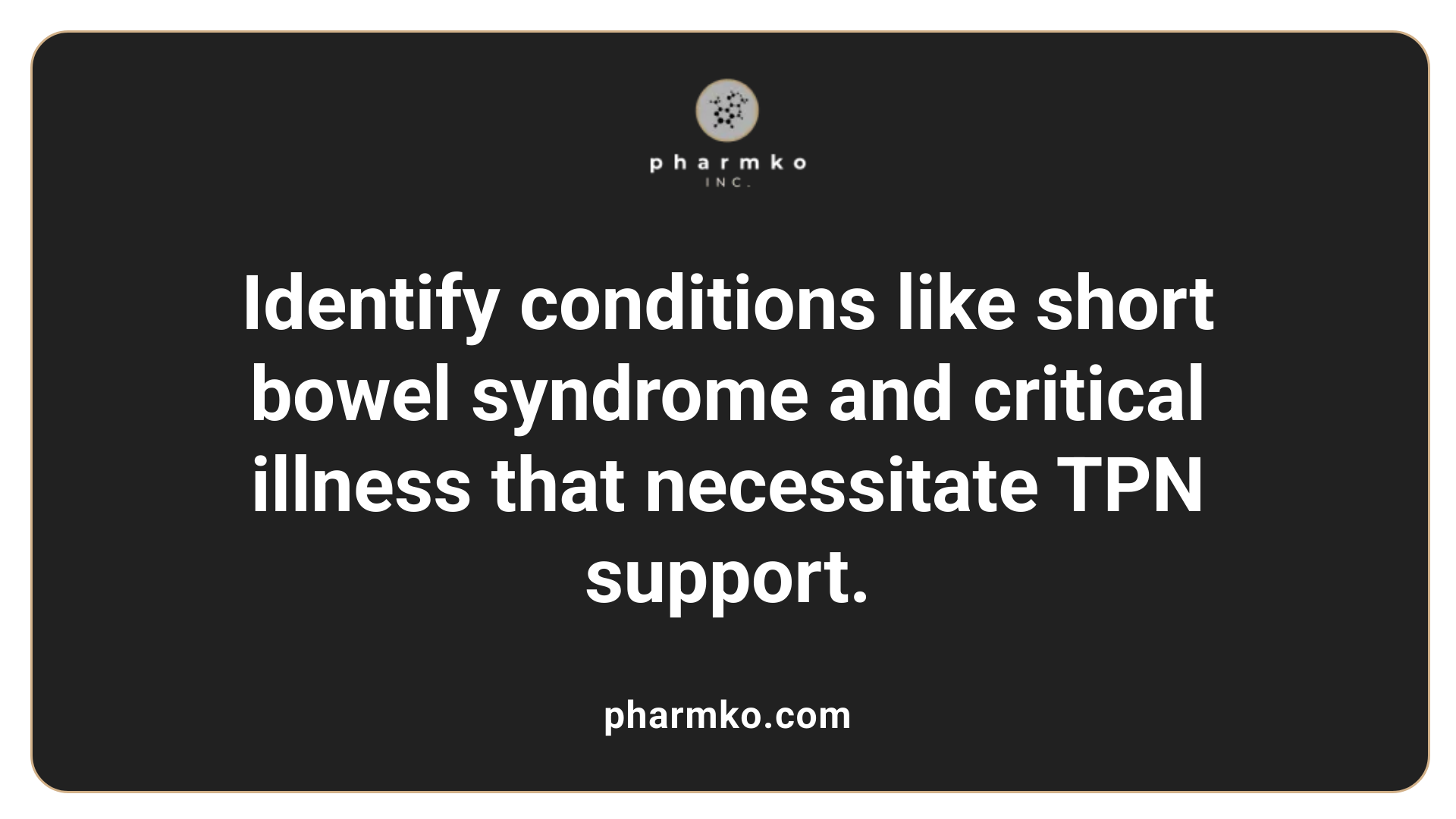
Where can I find comprehensive information and guidelines about Total Parenteral Nutrition (TPN)?
For healthcare providers and interested parties seeking detailed information on TPN, the most reputable sources are organizations like the American Society for Parenteral and Enteral Nutrition (ASPEN) and the European Society for Clinical Nutrition and Metabolism (ESPEN). These organizations develop comprehensive, evidence-based guidelines that cover all aspects of TPN, including indications, contraindications, formulation, administration techniques, and monitoring protocols.
In addition to official guidelines, medical textbooks, peer-reviewed journals, and specialized clinical literature provide valuable insights. Hospitals and professional medical associations also publish protocols and educational materials to support safe TPN practices. Accessing these resources ensures proper implementation, safety, and up-to-date clinical standards.
A useful search phrase for further information is "Total Parenteral Nutrition guidelines and protocols," which directs to authoritative guidelines and current best practices.
What medical conditions necessitate the use of Total Parenteral Nutrition (TPN)?
TPN becomes essential in various medical scenarios where the digestive system cannot effectively absorb or process nutrients.
Conditions requiring TPN include:
- Severe gastrointestinal (GI) obstructions like bowel blockages caused by tumors or strictures.
- The presence of fistulas, abnormal connections between organs that impair nutrient absorption.
- Chronic inflammatory conditions such as Crohn’s disease and ulcerative colitis, especially during flare-ups.
- Short bowel syndrome, often following surgical removal of parts of the intestine or due to disease-related damage.
- GI failure, which can be a consequence of extensive surgeries, radiation therapy, or ischemia.
- Malnutrition resulting from prolonged inability to eat or absorb nutrients.
- Postoperative scenarios like bowel leaks or anastomotic complications preventing enteral feeding.
- Critical illnesses such as sepsis, severe trauma, or burns that increase metabolic demands beyond what entersal nutrition can meet.
- Pediatric disorders, including congenital bowel anomalies and conditions requiring bowel rest.
In all these contexts, TPN provides necessary calories and nutrients directly into the bloodstream, bypassing problematic gastrointestinal pathways and supporting the patient’s nutritional status.
Additional Resources
Healthcare professionals are encouraged to consult current guidelines, peer-reviewed studies, and institutional protocols to optimize TPN use. Proper knowledge reduces risks like infection, metabolic disturbances, and liver complications, ensuring effective patient care.
The Composition of TPN and Customization for Patient Needs
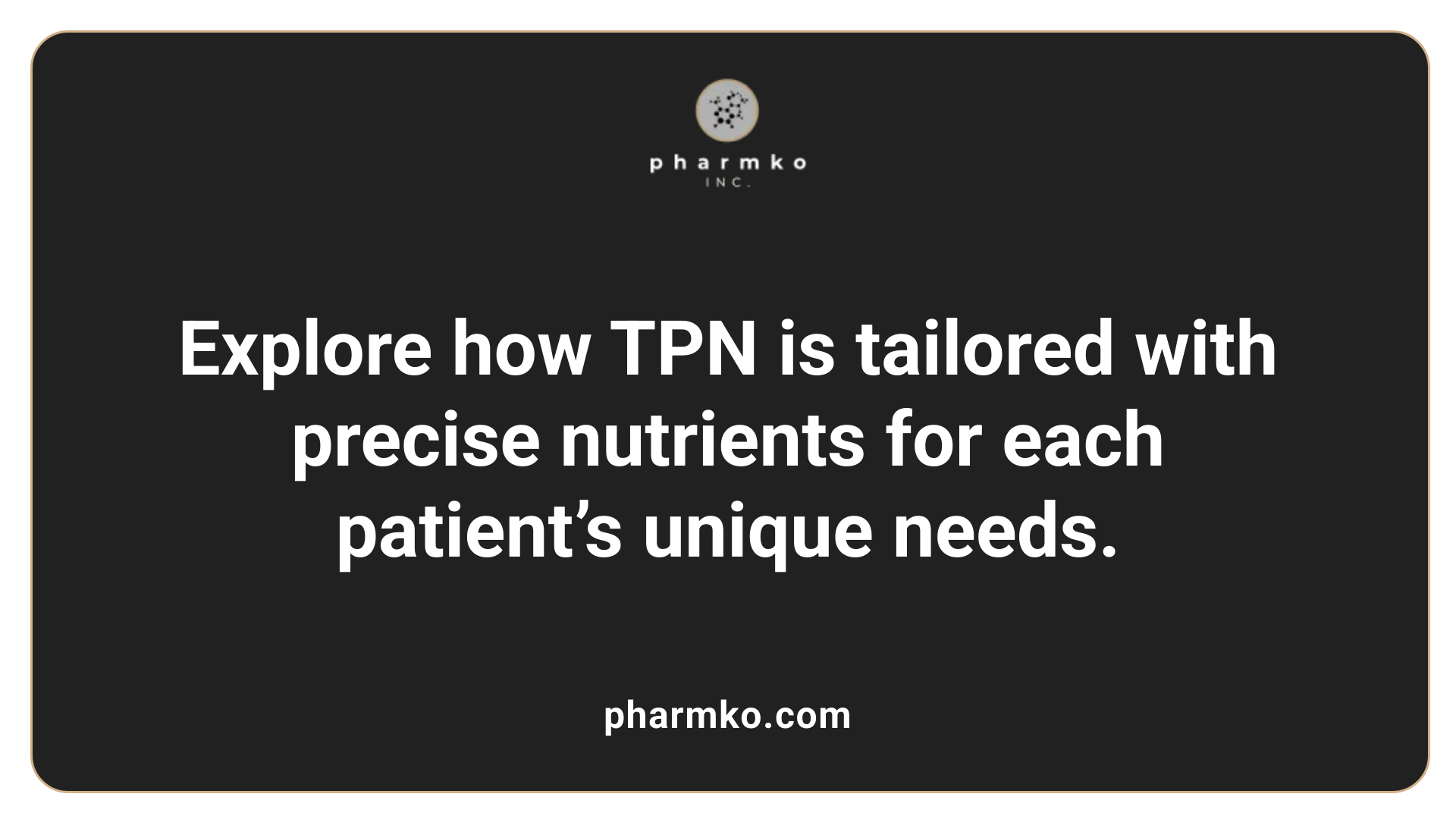
What is the typical composition of TPN solutions?
Total Parenteral Nutrition (TPN) solutions are carefully formulated mixtures designed to meet the nutritional requirements of patients who cannot digest or absorb food through their gastrointestinal tract. These solutions primarily include amino acids for protein, dextrose (glucose) for carbohydrate energy, and lipid emulsions for fats.
In addition to these macronutrients, TPN solutions contain essential electrolytes such as sodium, potassium, calcium, magnesium, and phosphate. These minerals are vital for maintaining proper fluid balance, nerve function, and muscle activity.
Vitamins and trace elements, including multivitamins and mineral concentrates like zinc, selenium, and manganese, are incorporated to support biochemical processes and overall metabolic health.
Since each patient's needs are unique, the exact composition of TPN is tailored based on factors like age, weight, nutritional status, metabolic rate, and specific medical conditions. This customization helps optimize nutrient delivery and reduce potential complications.
How are TPN solutions adjusted based on patient metabolism?
The formulation of TPN is not static; it requires ongoing adjustments as the patient’s condition evolves. Frequent monitoring of laboratory parameters—such as blood glucose, electrolyte levels, liver and kidney function—is essential.
If a patient shows signs of hyperglycemia, the glucose component may be decreased, or insulin may be added to regulate blood sugar levels. Electrolyte imbalances, like hypokalemia or hyperphosphatemia, are corrected by modifying electrolyte concentrations in future TPN preparations.
Patients with liver dysfunction might need a different lipid source or reduced lipid content to prevent or manage fatty liver. For those with renal issues, mineral concentrations, especially potassium and phosphate, are closely regulated.
The goal of these adjustments is to match nutrient supply with the patient’s actual metabolic needs, promoting healing and recovery while avoiding complications such as refeeding syndrome, nutrient deficiencies, or toxicity.
Role of amino acids, lipids, dextrose, vitamins, and minerals
Each component of TPN serves a specific purpose:
- Amino acids: Provide essential and non-essential amino acids necessary for tissue repair, enzyme production, and immune function.
- Lipids: Deliver calories and essential fatty acids, help prevent fatty acid deficiency, and support cell membrane integrity.
- Dextrose: The primary carbohydrate source that supplies energy, supporting metabolic functions.
- Vitamins: Support various enzymatic reactions and overall metabolic health.
- Minerals and trace elements: Critical for bone health, blood cell production, nerve transmission, and enzymatic activity.
The balance among these components is adjusted based on individual requirements, ensuring that patients receive sufficient nutrients without excess that could lead to metabolic disturbances.
Monitoring and tailoring of solutions to individual cases
Creating an effective TPN regimen involves meticulous monitoring. Healthcare providers regularly check
| Parameter | Purpose | Monitoring Frequency | Adjustments Made |
|---|---|---|---|
| Electrolyte levels | Prevent imbalance and neurological issues | Daily to weekly during stabilization | Modify electrolyte concentrations in TPN |
| Blood glucose | Avoid hyper/hypoglycemia | Multiple times daily (especially initially) | Adjust dextrose or add insulin |
| Liver function tests | Detect early liver damage | Weekly or more frequently during long-term use | Change lipid sources, reduce caloric load |
| Renal function | Prevent renal burden | Weekly tests | Adjust electrolyte and fluid intake |
| Patient weight and clinical status | Ensure proper growth or maintenance | Daily weight assessment | Modify nutritional content accordingly |
These measures ensure that TPN therapy remains safe and effective. Education on proper catheter care, aseptic technique, and recognition of signs of complications is essential, especially when TPN is administered at home.
In summary, the composition of TPN is a sophisticated blend of nutrients tailored to individual needs, requiring diligent monitoring and adjustment to optimize therapeutic outcomes and minimize risks.
Indications and Clinical Scenarios for TPN Use
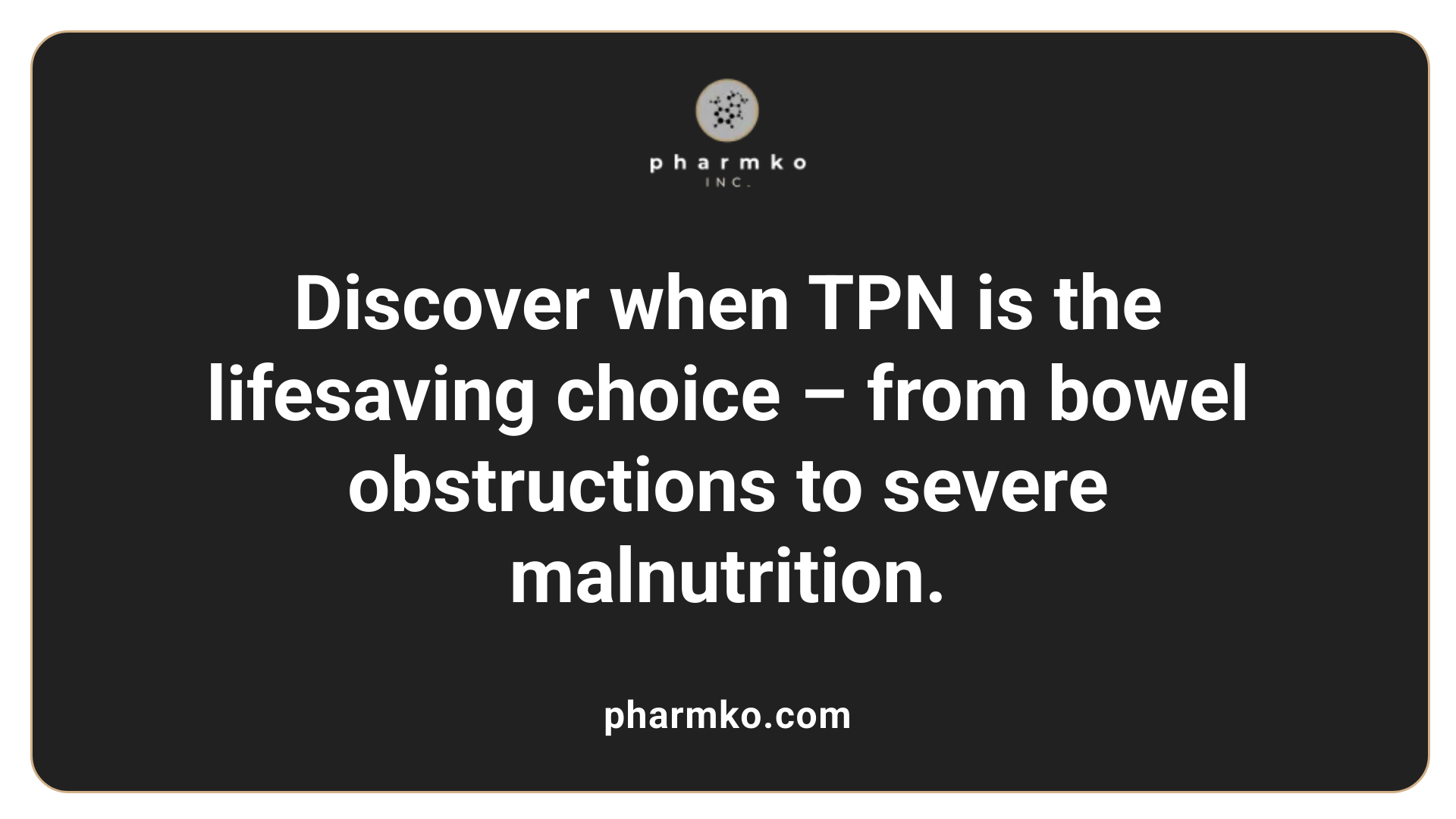
When is TPN indicated?
Total parenteral nutrition (TPN) comes into play when a patient’s digestive system is unable to absorb or tolerate food intake. It is primarily used in conditions where the gut cannot be effectively used for nourishment or needs to be rested. These include cases of severe bowel obstruction, perforation, fistulas, or extensive bowel damage.
Conditions like short bowel syndrome, malabsorption syndromes, and severe inflammatory diseases of the gut often necessitate TPN. Post-operative periods following significant gastrointestinal surgery, especially with compromised bowel continuity, also benefit from TPN to ensure adequate nutrition. Patients experiencing prolonged paralysis of the gut (ileus), severe pancreatitis, gastrointestinal bleeding, or infections requiring bowel rest are common candidates.
Absolute indications include permanent inability to absorb nutrients, such as after extensive bowel resection or chronic malabsorption. Relative indications cover severe malnutrition, unstable blood flow, or post-surgical recovery when enteral feeding isn't enough. The goal is to meet nutritional demands when oral or enteral routes are insufficient or impossible, but careful monitoring is essential to prevent complications.
Monitoring, Complications, and Outcomes of TPN Therapy
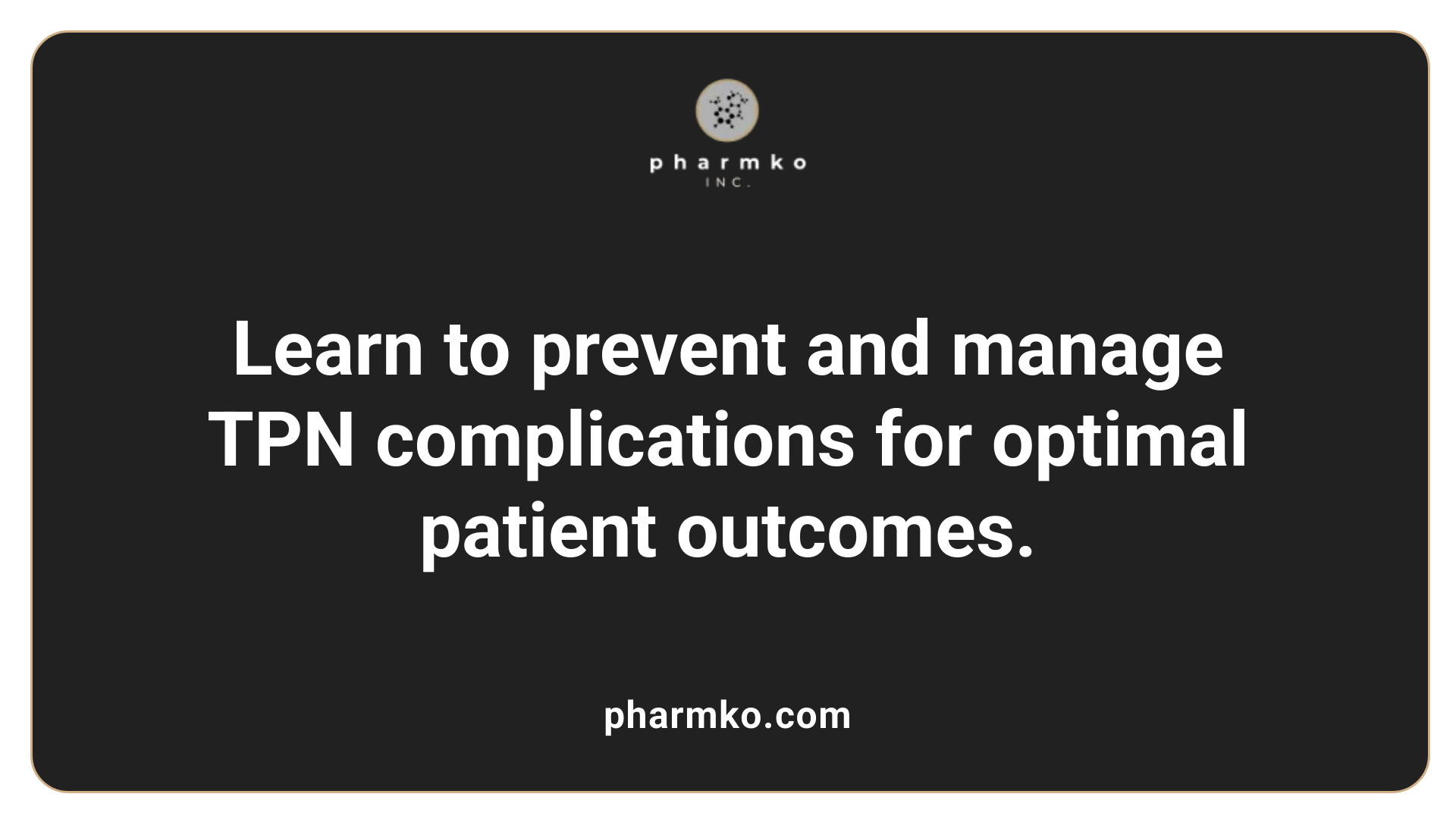
What are the guidelines for the administration of TPN, and what are the best practices for nurses?
Guidelines for the administration of TPN focus heavily on maintaining a sterile environment, precise formulation, and vigilant monitoring. Proper catheter placement, usually through a central vein, must follow sterile technique to prevent infections. TPN solutions are customized based on individual patient needs, with components like dextrose, amino acids, lipids, vitamins, and minerals carefully balanced.
Nurses play an essential role in adhering to best practices. This includes strict hand hygiene, checking TPN bags for expiration, leaks, and color, and warming the solution appropriately before administration. Monitoring blood glucose levels, electrolytes, and patient weight regularly allows early detection of metabolic disturbances. During infusion, vigilant observation for signs of infection, catheter dislodgment, or vascular complications is necessary.
Administering TPN via a continuous infusion rate through a central venous catheter and gradually adjusting the flow to meet the patient's caloric needs contributes to safety. Patient education is crucial, especially when TPN is home-based, encompassing signs of complications and proper device handling. Regular follow-up, clinical assessments, and adherence to safety protocols help optimize outcomes and reduce adverse events.
What are the common complications associated with Total Parenteral Nutrition (TPN)?
Complications linked to TPN are diverse but manageable with proper care. Infections, especially bloodstream infections related to catheters, are among the most serious, caused by bacteria entering via contaminated line access.
Metabolic complications are common and include hyperglycemia, hypoglycemia, electrolyte imbalances, and refeeding syndrome, which can be life-threatening if not promptly recognized. Lipid overload may lead to hypertriglyceridemia. Long-term TPN use may cause liver problems such as fatty liver, cholestasis, and fibrosis, which can progress to cirrhosis.
Mechanical issues include catheter thrombosis, occlusion, dislodgement, and air embolism, posing risks of vascular injury and embolic events. Gut atrophy may occur if the intestine is neglected during extended TPN use, which can impair recovery.
The overall risk profile emphasizes the importance of strict aseptic technique, regular monitoring of clinical and laboratory markers, and prompt management of complications.
How does TPN use affect patient outcomes and survival?
TPN significantly impacts survival and quality of life for patients with intestinal failure or other conditions preventing adequate nutrient absorption. It offers a bridge to recovery or a long-term solution, enabling malnourished patients to improve their health status.
Studies show that approximately 58% of long-term TPN patients survive beyond five years, with three-year survival rates reaching 65-80% depending on underlying health conditions.
However, TPN is associated with increased mortality risks; about 30 deaths per 100 patient-years. Factors influencing outcomes include age, presence of comorbidities like cancer, and ICU admission during therapy.
In some cases, especially where prognosis is poor, intestinal transplantation becomes an option, providing potential for better quality of life and survival.
To optimize outcomes, multidisciplinary care involving physicians, pharmacists, dieticians, and nurses is essential. Proper management minimizes complications and enhances the potential for longer, healthier life while on TPN.
| Aspect | Effect | Considerations |
|---|---|---|
| Survival Rates | Approximately 58% survive >5 years | Depends on underlying disease |
| Mortality Rate | 30 deaths per 100 patient-years | Long-term risks require close monitoring |
| Complication Management | Infections, organ dysfunction | Use aseptic technique, routine labs |
| Quality of Life | Improved nutrition, possible independence | Patient education crucial |
What are the long-term considerations and risks with TPN?
Extended use of TPN raises several long-term health considerations. Liver disease is among the most common concerns, manifesting as fatty liver, cholestasis, or fibrosis, often related to lipid composition and caloric load.
Bone demineralization and metabolic bone disease may occur, leading to osteoporosis or osteomalacia, especially if nutritional components are imbalanced.
Electrolyte disturbances, glucose intolerance, and micronutrient toxicities—such as manganese accumulation—can develop over time.
Catheter-related complications, including thrombosis and infections, pose persistent risks. Maintenance of catheter integrity and strict aseptic protocols are vital.
Gastrointestinal atrophy can be an issue if the bowel is not used or stimulated, which may impair recovery or ability to transition back to enteral feeding.
Long-term monitoring involves regular liver function tests, bone density scans, and nutritional assessments to detect and manage these risks proactively.
How does multidisciplinary care enhance TPN safety and effectiveness?
Managing TPN effectively requires a team approach. Physicians determine indications, adjust formulations, and oversee overall care.
Pharmacists prepare and check the solutions, ensuring correct composition and sterility. Dieticians evaluate nutritional requirements, balancing caloric, protein, and micronutrient needs based on ongoing assessments.
Nurses are responsible for administering TPN, maintaining catheter care, and educating patients, especially those receiving home TPN.
This collaborative approach minimizes complications, promotes early detection of adverse effects, and optimizes nutritional outcomes. It ensures that each aspect of care—from formulation to patient education—is tailored to the individual's needs, reducing hospitalizations and improving life quality for those dependent on TPN.
Comprehensive Management and Future Perspectives in TPN
Total Parenteral Nutrition remains a cornerstone in the management of complex gastrointestinal disorders and severe malnutrition. Advances in formulation, delivery systems, and multidisciplinary care have improved patient safety and outcomes. Ongoing research focuses on minimizing complications, optimizing metabolic support, and exploring regenerative therapies like growth hormone use in conditions such as short bowel syndrome. As knowledge expands and technology evolves, TPN will continue to be a critical tool in ensuring nutritional adequacy and improving life quality for patients with limited options for enteral feeding.
References
- Conditions Treated - Total Parenteral Nutrition - Stanford Health Care
- Total Parenteral Nutrition - StatPearls - NCBI Bookshelf
- Parenteral Nutrition: What it Is, Uses & Types - Cleveland Clinic
- Parenteral Nutrition (PN) - Nutritional Disorders - Merck Manuals
- Conditions Requiring Total Parenteral Nutrition
- Parenteral nutrition - Wikipedia
- When is parenteral nutrition indicated? - PMC - PubMed Central



